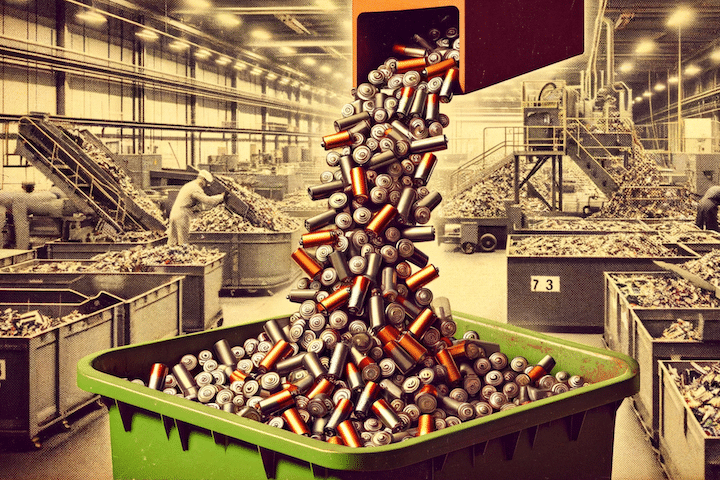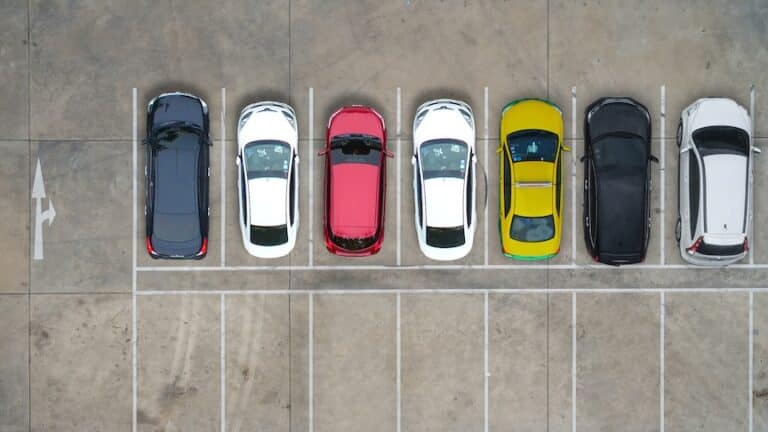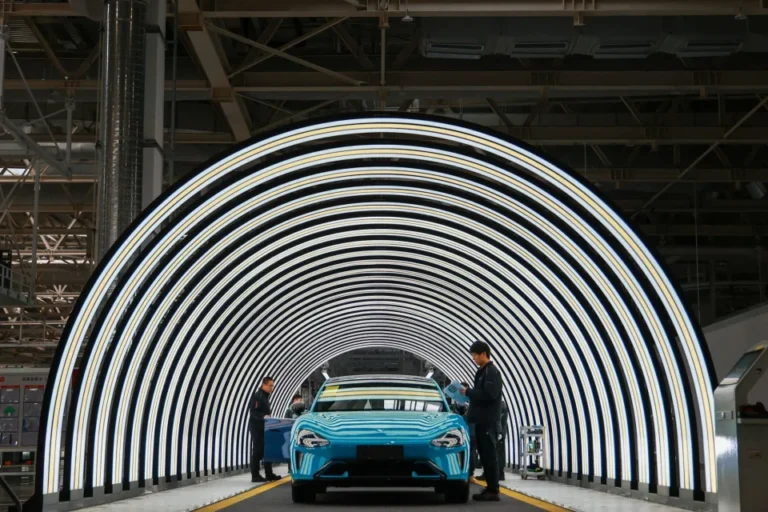Could a strategic lithium reserve kickstart US supply chain development?
NEW YORK -- A strategic lithium reserve is being mooted as a solution to stabilize volatile prices that have hindered American mining projects, allowi
Current Access Level “I” – ID Only: CUID holders, alumni, and approved guests only
Melissa Lott: [00:00:00] Around the time that her son started getting sick. Anna Gonzalez was also noticing some changes in her neighborhood. For example, she woke up one day and looked outside. [00:00:11][11.0]
Anna Gonzalez: [00:00:12] There was a massive building, a massive wall right in front of my house across the street. [00:00:17][5.6]
Melissa Lott: [00:00:18] Anna grew up in Rialto, California. It was a quiet agricultural place filled with orange groves and vineyards. But now a massive building had gone up right across the street from her house and she hadn’t heard anything about it. And then these big trucks, you know, 18 wheelers, semi-tractor trailers, they started showing up everywhere in town. [00:00:36][17.8]
Anna Gonzalez: [00:00:36] The noise, the vibrations of the trucks, every time they would pass through my house, literally, sometimes a frame from my wall would fall. [00:00:43][6.8]
Melissa Lott: [00:00:44] It was around 2014 or 2015. And she asked around. She found out that the mystery building was a distribution center. The developer was supposed to have put out public notices to neighbors, but they did not. And she learned that the trucks were driving to and from lots of new warehouses. So she went to city council meetings and protested what felt to her like a really rapid shift. In Rialto, this quiet suburb with its orange groves and vineyards, was quickly turning into a major logistics hub for big companies like Amazon. And Anna learned about all this development. But she still didn’t understand why her son was getting sick. He was having breathing problems. [00:01:17][32.9]
Anna Gonzalez: [00:01:18] He was frequently visiting the E.R. with bronchitis and pneumonia. I thought I was doing something wrong. I’m like, I’m not feeding my son right. Am I not, you know, keeping them safe at home? Like, what is that? So I started blaming myself for his illness. [00:01:34][16.5]
Melissa Lott: [00:01:35] A doctor they saw ran some tests and said her son was developing asthma. To Anna, that was confusing. [00:01:40][4.8]
Anna Gonzalez: [00:01:41] He eats very healthy. I don’t understand. We don’t have any pulmonary illness history in our family, so I don’t understand why this is happening. And he just straight up told me. He said it’s the environment. [00:01:53][12.2]
Melissa Lott: [00:01:58] The environment, air pollution. The doctor said it was weakening his lungs and was leaving him vulnerable to infections soon, and his son started to carry an inhaler around school. And Anna watched as her son started having trouble in gym class and on the baseball team. And one day at baseball practice, she started talking to other moms about the other kids that were having breathing problems, too. [00:02:17][19.7]
Anna Gonzalez: [00:02:18] I started realizing that literally, like 50% of my son’s team had asthma. And these moms are like sharing these home remedies and and different breathing treatments that they use for their kids to help them, you know, continue the sports. But in my son’s case, it just got worse and worse. And he just gave up and didn’t want to continue playing. [00:02:40][21.8]
Melissa Lott: [00:02:40] Anna started looking into all the changes that were going on around her. The rapid redevelopment of Rialto, the truck traffic, the air pollution that was making her son so sick, and how they were all connected. Anna wanted to create a healthier environment for her son, so she got involved with people who were fighting back. This is the Big switch, a show about how to rebuild the energy systems that are all around us. To slow climate change, we need to transform our buildings, homes, cars and the economy as quickly as possible. But how do we do it right? I’m Dr. Melissa Lott, and I’m the director of research at Columbia University’s Center on Global Energy Policy. And I study the technologies and systems that power our world. This episode is all about heavy duty vehicles and how decarbonizing big trucks is not only important for getting us to net zero, but it’s also important for protecting our health today. [00:03:36][55.5]
Anna Gonzalez: [00:03:41] So behind me you’ll see a map of what we know as the Inland Valley region and specifically the epicenter of the warehouse influx. [00:03:50][8.8]
Melissa Lott: [00:03:51] Anna got involved with the groups that were already protesting pollution in Southern California, including an environmental justice organization called the Center for Community Action and Environmental Justice, or K.J. for short. She’s now the organization’s interim executive director. On the wall of her office, she has this green, yellow and red map of the counties of the inland Valley region of California. Some people also call it the Inland Empire. [00:04:14][22.9]
Anna Gonzalez: [00:04:15] When you get to the yellow green, dark green areas, those are the areas where the wealthy folks live. They’re more of the white, affluent regions of our of our counties. [00:04:25][10.3]
Melissa Lott: [00:04:26] The map is from the California Environmental Protection Agency. And while the green spots show us air pollution, the red spots are where the air pollution is the worst. [00:04:34][7.9]
Anna Gonzalez: [00:04:35] These are bipoc communities, black, indigenous people of color, community members. [00:04:39][4.1]
Melissa Lott: [00:04:40] When we hear about environmental racism, this map is a clear visualization of what it looks like. Southern California has the worst air quality in the U.S., according to the American Lung Association. And there are a bunch of sources of air pollution in those red areas. Railyards and oil refineries and other industries have long been cited in predominantly poor communities of color. There’s a whole web of environmental justice issues that need to be addressed in these places. But one of the worst offenders is something called PM 2.5. We’ve talked about these bodies before. They’re tiny particles that can get into our lungs and even into our bloodstream and cause a ton of harm, including the kinds of harm that contribute to asthma, cardiovascular disease, chronic obstructive pulmonary disease or COPD, and dying from COVID among a lot of other things. [00:05:25][45.3]
Anna Gonzalez: [00:05:26] And so the redder the area, the more impacted the area is and the more dangerous it is for folks to breathe. [00:05:32][6.4]
Melissa Lott: [00:05:33] Doctors, environmental groups and activists call some of these red spots diesel death zones. [00:05:38][4.5]
Faraz Rizvi: [00:05:38] So diesel dead zones is a term that was coined by physicians and it explains the health impacts of the high volume of trucks that we see in regions like the Inland Empire. [00:05:49][10.9]
Melissa Lott: [00:05:50] This is Faraz Rizvi, a colleague of Anna’s at CCR. [00:05:53][2.8]
Faraz Rizvi: [00:05:54] You can have one warehouse that has a line of trucks sitting outside and that might not be a diesel death zone. But if you have 20 warehouses in one area and you have trucks coming in and out, well, now you have an entire environment which is cited with toxic pollution and this becomes very dangerous. [00:06:11][16.6]
Melissa Lott: [00:06:13] There are a lot of different things that could reduce and eliminate the impacts of diesel trucks. One promising option is switching diesel trucks to electricity. [00:06:20][7.2]
Faraz Rizvi: [00:06:21] Electrification can actually have a huge public impact in eliminating these diesel dead zones. So what we’re really hoping for is for electrification to provide a zero emission standard for which if warehouses are going to be in the Inland Empire, which they already are, we make sure that they’re not polluting our communities and harming us. [00:06:42][20.6]
Melissa Lott: [00:06:42] You’ve probably seen a Tesla. Maybe some of you have even heard about the electric consumer trucks like the Ford F-150, Lightning. But could we have electric big rigs? And more broadly, what are the solutions that we have for eliminating all different kinds of emissions, not just moving us to net zero, but also cleaning up the air in these neighborhoods that have been the hardest hit by poor air quality and environmental racism. The good news is that there’s a ton of new momentum in cleaning up heavy duty trucking. [00:07:11][28.7]
Dr. Ben Sharp: [00:07:12] So just in the past two or three years, we’ve seen a tremendous sea change in terms of the interest and just the belief in the commercial viability of electrification for for heavy duty vehicles and trucks in particular. [00:07:25][13.4]
Melissa Lott: [00:07:26] This is Dr. Ben Sharp. He’s a senior researcher at one of those big organizations that’s trying to figure out how to decarbonize transportation. It’s called the International Council on Clean Transportation. Ben works on heavy duty vehicles, and he’s seen a whole lot of new momentum around reducing emissions from trucking. Part of that momentum comes from business innovation. [00:07:44][17.9]
Dr. Ben Sharp: [00:07:45] We do these analyzes every few months and, you know, the minute that we put out a paper, it’s already out of out of date because, you know, these these companies are being very aggressive in bringing products to market. [00:07:55][10.4]
Melissa Lott: [00:07:56] But it’s also coming from lawmakers. [00:07:57][1.3]
Dr. Ben Sharp: [00:07:58] California has continued to play the role as trailblazer. And I’ve been leading the charge, pun intended, in terms of commercial vehicle electrification. So the Advanced Clean Trucks regulation, which was finalized in summer of 2020, that was kind of the first really big domino to fall in the policy space. [00:08:17][19.2]
Melissa Lott: [00:08:18] I spoke to Dr. Sharp about these rapid changes that are happening in trucking, including California’s new Clean trucks rule. That big domino he’s talking about, the first we zoomed out to get a handle on the scope of the problem. [00:08:29][10.9]
Dr. Ben Sharp: [00:08:30] In terms of the overall population. I think they probably make up maybe four or 5% of the overall vehicle fleet. But when it comes to pollution and we can pick particulate matter or oxides of nitrogen, nitrogen oxides, the heavy duty tractor trailers make up in some places 50% or more of the emissions. But from a fuel use and climate perspective, they’re also significant in terms of their contribution. Tractor trailers make up around 60% of the fuel use and greenhouse gas emissions from from the heavy duty vehicle sector. [00:09:06][35.4]
Melissa Lott: [00:09:06] So if we step back for a minute at a high level, what is it going to take to decarbonize these heavy vehicles, both incrementally, you know, near-term progress, but also to get all the way to net zero, which is different than just improvements? It’s a lot further. What is it going to take to decarbonize these vehicles? [00:09:24][17.7]
Dr. Ben Sharp: [00:09:25] Yeah, well, it’s fascinating. And I think it’s a really dynamic time for the industry. So we’re seeing battery electric trucks that are already available commercially. I mean, hydrogen fuel cell trucks are not too far behind. We’ll probably expect to see those over the next one or two years available for purchase. But those are the really big ticket items. So getting to zero emissions is really the endgame. And it’s really fascinating to see just how quickly the industry has kind of coalesced around this idea that we just it’s not a matter of if at this point, but how fast we have to get to zero emissions. You know, lots of governments are starting to put targets in place for heavy duty trucks in particular. Just last week at COP26 in Scotland, we had news for I think it was 15 countries have announced that by 2040 they want to get to 100% zero emission sales for for the freight truck sector, which is really exciting and very ambitious. So freight trucks in particular pose a really significant challenge, mostly due to how big they are. So in terms of engineering, it’s by no means like super complicated. You know, these are really just kind of bigger versions of Teslas or Nissan leaves or battery electric vehicles that are that are in the passenger vehicle sector. But when you talk about how heavy they have to be and the loads that they have to carry, that’s what makes electrification such a such a big challenge for the trucking sector. So the heavy weights and also some of the severe service. So trucks, you know, really have to be able to do all types of different service, you know, whether it’s port operations or, you know, putting lots and lots of miles on the highway. You know, we mentioned refuse or concrete mixing. So there’s all these different flavors of of trucks and busses that are out there. So the engineering involved is definitely a bit more complicated. But at a high level, these manufacturers know how to do this. And it’s just a matter of getting the cost down and getting the fleets comfortable with the technology. [00:11:41][136.6]
Melissa Lott: [00:11:43] So I want to step through this. When we think about incremental progress, the things we can do to start bringing down emissions step by step when it comes to heavy vehicles. What is included in that bucket. [00:11:52][9.7]
Dr. Ben Sharp: [00:11:53] In terms of the technologies and include everything from aerodynamics to improved tires, engine efficiency, transmission improvements, reducing parasitic loads. Having more efficient accessories. So there’s really just a plethora of technological solutions that are available. But also on the operations side, we don’t want to discount those because they’re significant. The biggest one being the driver. We often try and remind ourselves that the driver is the most important piece of technology on the vehicle. We’ve seen anecdotally and even there’s some data to prove this that you’re swinging from a not so good driver to an excellent driver can be 30% or more in terms of fuel efficiency, which is huge. Right. It’s absolutely. [00:12:40][47.4]
Melissa Lott: [00:12:41] Staggering. [00:12:41][0.0]
Dr. Ben Sharp: [00:12:42] And it is. It is. So, you know, you’ll definitely see companies that are laser focused on fuel efficiency. They will absolutely have driver training, driver coaching in cabin technologies to help them because it’s absolutely critical that the driver is a big part of of fuel efficiency. And what we think is pretty cool is when fleets actually incentivize drivers to be more efficient and actually give them financial rewards or, you know, do fuel economy competitions or, you know, have prizes and and just really make it more fun and have them buy in more to this whole idea of fuel efficiency. [00:13:23][41.1]
Melissa Lott: [00:13:24] So we’ve got our incremental things, the things that take down emissions, you know, step by step. So we keep human mode of emissions down. What about more radical changes? What about these big technology shifts? What does that include? What does that look like? [00:13:36][12.3]
Dr. Ben Sharp: [00:13:37] Yeah, I would say that that for us, we see radical shifts in terms of using different fuels and or powertrain. So that was certainly includes zero emission solutions, but also, you know, natural gas, you know, biofuels, those would definitely be in that category as well. [00:13:55][17.8]
Melissa Lott: [00:13:55] How important are the incremental changes compared to these radical shifts? [00:13:59][3.6]
Dr. Ben Sharp: [00:14:00] So the incremental improvements in energy efficiency are absolutely critical. There’s really no chance of us getting to our, you know, ultimate net zero goals if we don’t continue to invest and demand that our vehicles are more energy efficient. You know, aerodynamics and tire efficiency, reducing parasitic loads, all of these types of technologies are going to be applicable in the future. When we’re when we’re looking at zero emission trucks as we start to have more and more zero emission vehicles in the fleets. We’re going to have to demand that those those vehicles use there, whether it’s electricity or hydrogen as efficiently as possible as well. [00:14:43][42.9]
Melissa Lott: [00:14:43] I think about this one actually a lot like buildings where we have a lot of buildings that are already here. And so incremental improvements in efficiency are huge in reducing emissions and how we retrofit what can we do with existing things that are already in the ground. It feels like that’s similar with trucks that. Is that right? [00:15:01][17.2]
Dr. Ben Sharp: [00:15:01] Absolutely. Absolutely. It’s a great analogy. The existing in use fleet is huge and is going to be with us for many, many years. So even if we stopped selling diesel trucks in, you know, say five or ten or 15 years, we’re still going to have a considerable amount of diesel trucks, legacy trucks that are on the road. And, you know, outside of a ban of those vehicles operating, these trucks can last for a long, long time. For a diesel engine, a million miles is kind of standard in terms of what the expectation is for their life, which is staggering. Right. We’re not used to seeing that in the passenger vehicle space. But for trucks, you know, it’s not uncommon at all to see a 20, 25, 30 year old truck that’s still in operation. [00:15:52][50.8]
Melissa Lott: [00:15:53] How long does it take today to fill up to put, you know, diesel into a truck, to fill it up from, you know, empty to full? How long will that take a driver? And then if we think about the future in a net zero world, if that was an electric truck, how long would it take to charge it? [00:16:08][15.2]
Dr. Ben Sharp: [00:16:08] Yeah. So I would say a typical fill experience for diesel is probably on the order of like 15 to 20 minutes. And thinking about, say, a battery electric truck. And I think that this is one of the most critical barriers for battery electric technology in the trucking space because even if you have, say, 350 or 500 kilowatt charger, which is really substantial, even in those instances, it’s not going to be a 15 minute, you know, recharge experience. If you you know, you’re talking a, you know, at least an hour or two to refill those batteries. And if you have a slower charging experience, so say maybe 100 kilowatts, you know, you’d be looking at, you know, 8 to 10 hours of recharging to get a full charge. So I think that that’s one of the really critical pieces that the industry. And government regulators are going to have to figure out with regards to battery electric trucks in particular. So, you know, whether it’s getting, you know, megawatt or even larger chargers to give that very quick 20 to 30 minute recharge or you’re going to have to have trucking fleets just really kind of radically shift the way that they do business. So one of the things that we’ve been tracking very closely is the opportunities for hydrogen fuel cell vehicles. And I think one of the main value propositions for the hydrogen truck as opposed to battery electric is having that more diesel like refueling experience. So 15 to 20 minutes is more reasonable on the on, you know, an expectation for hydrogen. [00:17:54][105.1]
Melissa Lott: [00:17:55] So you mentioned fleets. And often when we think of heavy trucks, we think of those fleets that we see going down the road, whether it’s Wal Mart, Amazon, increasingly, you know, companies that own a lot of trucks or at least their brand, a lot of trucks. But if I’m not mistaken on the numbers, actually, when you think about heavy trucks, most of them are owner operators. So these small companies, maybe they own a few trucks, a dozen trucks, these types of things. What does that mean in terms of adopting technologies and this path to net zero? How significant is. [00:18:28][33.9]
Dr. Ben Sharp: [00:18:29] That? It’s a super important dynamic. So we expect that the early market for zero emission trucks is likely to be dominated by these larger types of fleets that you mentioned. So the Wal-Marts, the Amazons, the Snyders, the Riders, you know, these are the companies that are typically very well capitalized. They can afford to make these investments in zero emission trucks and the necessary infrastructure. So at least for the foreseeable future, I think we’re expecting that the vast majority of these these news, your emission trucks are going to be going to these larger fleets. What’s really, really critical in our view is once you start to see zero emission trucks that are used become available in the secondary markets, because for those smaller fleets, the owner operators, small enterprises, those are the companies that are mainly buying used trucks. So we probably won’t expect to see zero emissions start to hit those smaller companies, probably not for another five or seven years at least. We we would probably expect that it’s going to take some time, one for the larger fleets to just get some information about these these new trucks, you know, kick the tires, see how they work. You know, do they actually offer a value proposition from an economic perspective? And then, you know, once the is a bit more proven, then we’re probably going to expect to see it trickle out throughout the rest of the industry. So, you know, when you’re smaller companies, your owner operators, but I think it’s just a very tall order to expect these small companies that just typically don’t have that much access to capital, don’t have a, you know, dedicated sustainability officer to to figure out, you know, what these trucks are all about and how do we actually use them. Who’s my utility? Where am I going to get power from? There’s so many questions when it comes to introducing these zero emission trucks and most of these small companies just, you know, are just trying to make a living. And often driving and getting loads is rightly their focus. So we’re dependent on these larger companies to to kind of ground truth the technology and kind of share their learnings with the rest of the industry. [00:20:59][150.0]
Melissa Lott: [00:21:00] So when we talk about all the diesel trucks are on the road today and we think about the transition, what happens to all of those trucks, like where do they go? [00:21:09][9.1]
Dr. Ben Sharp: [00:21:09] So typically the life cycle of a truck will be that its first owner is a very large fleet, large or maybe even a medium sized fleet, but it’s going to put a lot of miles on it. So on average, say around 150,000 miles per year over those first few years. So you can easily see a truck after four or five years that will have a half a million miles on it. And after that first very intensive service, it’ll typically go to to its second owner and probably go into more of a regional type of a drive cycle where it’s operating around cities and urban areas. Probably not going to be doing as intensive in terms of those highway miles. So maybe it’s doing, you know, 75 or 80,000 miles a year. So you’ll you’ll see the trucks with. That second owner. Maybe it’s maybe he or she owns it for, you know, another five or six or seven or eight years. And then finally, kind of the the last stop for most semi-trucks is in port service. So your oldest trucks typically go to port operations as kind of their last stop. So it’s typical to see trucks that are very old. Often your most polluting trucks are going to be in port service, which is why ports have really kind of become an epicenter for this environmental justice movement, because the communities that are around ports typically suffer some of the worst air quality and health outcomes. So you have these communities that are really demanding solutions and often that that looks like, you know, getting newer trucks and nowadays starting to transition to zero emission trucks. So California in particular, and this is by no means a California only issue, but California has been the most aggressive in terms of kind of outlining a transition plan for for dredge and port trucks. So more or less, by 2035, California is mandating that all trucks that serve ports are going to have to be zero emission. And I think starting in 2023, only zero emission trucks are going to be allowed to be registered at the ports. So if you’re currently a diesel truck, you’re grandfathered in. But starting in 2023, if you want to get on the registry, you’re going to have to have a zero emission truck. It’s a very doable operations demand for the truck. So you’re not putting on a ton of miles. You typically are going to be able to return back to base and either charge or refuel, which is very important for zero emission trucks. We’re actually already seeing a lot of it in the ports of Long Beach and Los Angeles and Oakland. These have been kind of the pilot and demo ground zero for a lot of these demonstration projects have happened in these these ports. So it’s going to be fascinating to see, you know, what’s the role of government policy? You know, how can we support small businesses in these owner operators? I don’t think anybody in California in terms of policymakers, you know, they don’t want to see these small businesses decimated. And and, you know, these these men and women no longer able to make a living. So there’s definitely going to be a very big need for incentives and education programs and outreach, because, you know, these are mostly small businesses that are operating in the ports. [00:25:04][234.7]
Melissa Lott: [00:25:05] So one thing I’m thinking about which relates to policymakers, there’s this new clean trucks rule from CARB, the California Air Resources Board. And I’m thinking about how do these rules impact the communities that live around warehouses and logistics facilities, which are a key part of the trucking industry. [00:25:21][16.1]
Dr. Ben Sharp: [00:25:22] Yeah. So California, as it likes to be, has definitely been a trailblazer in the zero emission truck regulatory space. So last summer, California finalized the Advance Clean Trucks regulation, which at the time was the first regulation in the world requiring the sale of zero emission trucks. So the first set of requirements for the Advanced Clean Truck regulations start in 2024. I think right now you’re mostly limited to seeing trucks, zero emission trucks in demonstration programs, whether it’s at the port. There’s a few that are operating in cities, but for the most part, you know, when I’m driving around just, you know, Sacramento or the Bay Area, you’re not typically going to see a zero emission truck in service at least. Right? Right now, it’s pretty rare that you’re going to see them. But fast forward, you know, two or three years, once the advanced clean truck regulation is coming in 2 to 4, that’s when you’re going to start to really have a lot more of these trucks on the road. These earliest trucks are going to have more success when they’re operating in and around cities. And what’s great is that, you know, for the most part, communities around cities are where you’re having your your biggest impacts in terms of diesel pollution, negative health outcomes, etc.. So displacing trucks in the urban areas, getting those trucks to be zero emission, it’s. Going to be really exciting to see those those trucks actually start to have an impact on air quality for the communities that have been impacted most by diesel exhaust. [00:27:14][112.3]
Melissa Lott: [00:27:19] One of the communities that has been hardest hit by diesel exhaust is Rialto, California. Earlier in the show, we heard from Anna Gonzales and Faraz Rizvi. They’re organizing for cleaner air in the region. Rialto is a place for rapid growth of warehouses, and trucking has had a huge impact on air quality and respiratory health. According to data from the Public Health Institute from 2016 to 2018. The rate of emergency room visits from pneumonia in Rialto was 44% higher than the state average. This is one big reason why activists have been pushing for changes to air quality regulations like the Clean Trucks rule that Ben talked about in May of 2021. There was another important role being debated. Basically, we require that the biggest warehouses in the region adopt zero emission trucks or else they had to pay a penalty to support zero emission vehicles. It’s often known as the warehouse Indirect Sources Rule, or ISR. It was being voted on by this pretty important, but also fairly unknown governmental board in Southern California called the South Coast Air Quality Management District, or AQ, M.D.. Now, back in episode five, we talked about why the rules matter, and sometimes it could seem like wait. Warehouse ESR HQ empty one on earth are these acronyms and do I actually need to care about board meetings? But these rules really, really do matter. Lives are on the line, literally. And as it turns out, in Southern California, residents recognized how powerful these rules can be. The warehouse ESR was being debated at this kind of obscure government meeting, but hundreds of people dialed in to testify. [00:28:48][88.8]
Faraz Rizvi: [00:28:49] We testified and it was about 5 hours of community members saying we need clean air. It’s killing us. We can’t we can’t do this anymore. [00:28:58][9.6]
Melissa Lott: [00:28:59] Again, Anna Gonzales. I was able to share my story about my son and why this rule was so important, not only to my own children, but for the children everywhere in my region that are suffering from asthma and developing these illnesses that are caused by the pollution that’s being emitted by these trucks. And so, you know, hearing testimonies from all of our communities and why this was important to them and and just share their stories of their family members who had died from cancer or other moms that had their children that were struggling to breathe because they had severe asthma attacks and bloody noses. There’s so many retail companies with warehouses in Rialto that it’s been called America’s shopping cart. And Farrar argues that these companies can and should clean up their operations. [00:29:47][47.9]
Faraz Rizvi: [00:29:48] These companies that are profiting from the logistics sector can afford it. We can afford it. They can afford it. And if they don’t do it, this is part of the costs of free shipping. Our health, our lungs, our children’s health, our hospital visits. This is baked into the cost of that cheap shipping. [00:30:10][22.5]
Melissa Lott: [00:30:11] And those hours of testimony at the academy from hundreds of locals while they put pressure on the rule makers. And finally, the vote was taken and it was a huge win for the community. They could pass the warehouse and direct sources rule and required warehouses to adopt zero emission trucks or pay a penalty towards supporting zero emission vehicles. And both of these rules so carbs, clean trucks, rule and the south coast, AQ imd’s and sources rule. Well, they don’t really solve the immediate problem, but they’re steps in the right direction. And for people like Ana and her son, these changes could come a lot faster. Even now, Ana son is still struggling with asthma and Ana is doing everything that she can to help them get clean air. I was able to get special filters for my AC unit, and so we have the air running through the house with these special filters to make sure that at least he’s breathing clean air inside the home. But still, organizing by groups like C.J. is energizing people to show up and tell officials we want clean air now. And so this created a domino effect and mobilize more community members and to mobilize other neighbors or family members or friends to continue this advocacy. And we’re seeing it now with the city council meetings and school board meetings and county board of supervisor meetings as we continue the advocacy against these polluters that are coming into our region. And that’s our show. Next up on the Big Switch, you know about sound. We’re talking about decarbonizing the biggest ships in the world. The big switch is produced by Columbia University’s Center on Global Energy Policy in partnership with Post-Script Media. This episode was produced by Daniel Waldorf and Alexandra. Her theme, music, mixing and scoring was by Shawn Marquand. And a special thanks goes out to our Columbia team Kirsten Smith, Lee, Liz Smith, and Natalie Volk, our executive editor, Steven Lacy. I’m Dr. Melissa Lott. And this is the big switch. [00:30:11][0.0]
[1752.2]
Heavy trucks emit an outsize share of greenhouse gasses and toxic pollutants. But we rely on them for nearly everything we buy. What will it take to decarbonize them?
We hear from staff at the Community Center for Action & Environmental Justice. They’re demanding clean air in “America’s shopping cart,” a polluted region dominated by warehouses and trucking.
And Dr. Ben Sharpe of the International Council on Clean Transportation covers the technologies and policies we need to reach zero-emission trucking.
Guests: Dr. Ben Sharpe is a Senior Researcher at the International Council on Clean Transportation. Anna Gonzalez is the Interim Executive Director of the Center for Community Action and Environmental Justice (CCAEJ). Faraz Rizvi is CCAEJ’s Special Projects Coordinator.
The Big Switch is produced by Columbia University’s Center on Global Energy Policy in partnership with Post Script Media. This episode was produced by Daniel Woldorff and Alexandria Herr. Theme music and mixing by Sean Marquand. A special thanks to Natalie Volk, Kirsten Smith and Kyu Lee. Our executive editor was Stephen Lacey.
So far over this season we've traced the global lithium-ion battery supply chain from mining to processing to manufacturing. And we've put it all into a geopolitical and economic context.

China has been the world's biggest battery manufacturer for over a decade. By 2022, according to the IEA, China manufactured 76% of the world's batteries. But that's changing.

Batteries can replace gasoline in our cars, or diesel in our generators with electricity. But batteries and petroleum-based fuels share something in common: they both rely on energy-intensive processes to turn extracted materials into something useful.

To produce enough batteries to reach global net-zero goals, the International Energy Agency says we'll need to increase production of critical minerals by six fold by 2040. It's a monumental task.

As the US and Europe navigate a difficult and uneven shift toward full battery electric vehicles (BEVs), the US and EU auto markets are under heavy pressure.


High political walls are hurting an industry vital to the character of the country.

